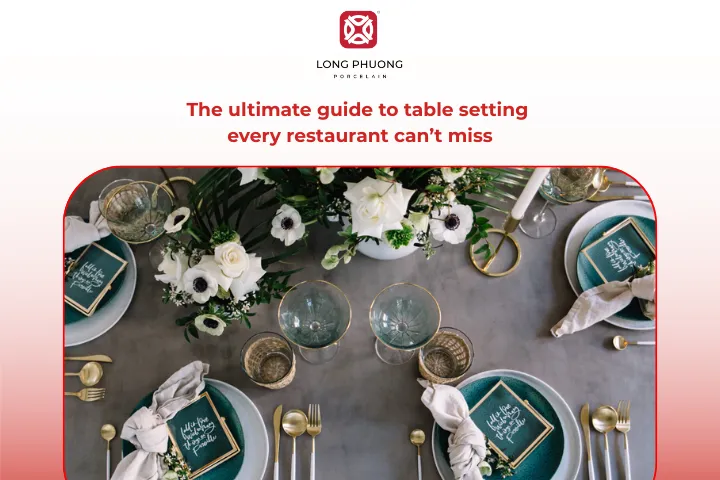In a restaurant, the way a table is set speaks volumes about the quality of the dining experience. A well-arranged table not only looks inviting but also reflects the restaurant’s attention to detail and professionalism. This guide shows how to create beautiful, inviting table settings that impress guests and elevate the dining experience.

1. What is table setting?
Table setting (laying a table) or place setting is the way tableware, utensils, and decorative items are arranged for a meal. Arrangements can vary widely depending on culture, occasion, and the number of guests.

2. Why table setting matters
Table setting is more than aesthetics in a restaurant; it plays a critical role in guest satisfaction. Properly arranged plates, cutlery, glassware, and décor create a sense of order and elegance while making service smoother for staff. A thoughtfully set table helps establish the restaurant’s quality and ensures diners feel comfortable and valued from the moment they sit down.

3. Basic table setting standards
Setting up tableware for a standard dining table is the first skill every restaurant staff member must learn. Here are the most common tableware setup guidelines:
- First, the table and all utensils must be clean, hygienic, free of strange odors, and neatly arranged.
- Arrange utensils from the outside in, following the order of the meal: appetizers, main courses, desserts.
- Plates should be placed about 2 cm from the edge of the table, centered in front of each seat.
- Bowls are placed upside down on the plates, arranged according to the number of guests, following a curved layout on a rotating table.
- Napkins are placed on top of the plate or bowl.
- Spoons and chopsticks should rest on their holders, about 2–3 cm from the plate.
- Glasses are placed above and to the right of the plate, about 1.5 cm away.
- Salt and pepper shakers are set in the center of the table.
- A decorative flower vase is also placed in the center of the table.

4. Regional table setting styles
4.1. Table setting for Asian-style restaurants
Tableware for an Asian dining setup usually includes a base plate, rice bowl, spoon and chopsticks, holders for the spoon and chopsticks, a small sauce dish, napkin, flower vase, toothpick holder, water glass, and wine or sake cup. Here’s how an Asian-style dining table is generally set up:
- The table and chairs must be clean and odor-free. Chairs are spaced about 20 to 24 inches apart, and each one should be placed 6 to 8 inches from the edge of the table, directly facing the dining set.
- A base plate is placed at the bottom, the rice bowl sits on top, and the neatly folded napkin is placed over the bowl.
- The spoon and chopsticks rest on their holders on the right side, about 0.8 inches from the base plate and table edge.
- Condiment containers, the toothpick holder, and the decorative flower vase are neatly arranged in the center of the table.
- Individual sauce dishes are placed in front of each setting, about half an inch from the plate.
- Water glasses are positioned to the right, slightly in front of the base plate.

4.2. Table setting for European-style restaurants
European-style dining tables are more refined and typically include a wider range of utensils. The number and arrangement of tableware may vary depending on the menu, but the basic rules remain the same:
- Each guest’s place setting includes a full set of plates, knives, forks, spoons, and glasses.
- The main course plate is placed neatly at the center of the setting. A smaller plate may be placed on top, with a folded napkin on it. The bread plate is positioned to the left of the main plate, often accompanied by a butter knife.
- Knives are placed to the right of the main plate, while forks are placed to the left. Additional utensils are arranged outside the main ones and adjusted according to the menu.
- Wine glasses are positioned above the knives, about 1.5 cm away, with a water glass to the right. The glass to be used first is placed on the right, and the one to be used later is placed on the left.
- Salt and pepper shakers are placed on the table, with their position adjusted to fit the table size.
- Always use the proper knife for each dish, and avoid placing more than three utensils of the same type together.

4.3. Table setting for American-style restaurants
Make sure you know exactly how these key pieces should be arranged on the table. This detail is what sets the American dining style different from other styles.
- Use a clean, white, ironed tablecloth hanging about 10–15 inches below the table edge. Placemats are optional and suited for casual meals.
- Place the main plate at the center, the bread plate at the top left with a butter knife if needed, and a folded napkin on or beside the plate.
- Forks go on the left, knives and spoons on the right, blades facing the plate. Arrange utensils from the outside in and never use more than three on each side.
- Include fish or oyster forks only if required. The dessert fork lies horizontally above the plate, handle to the left.
- The butter knife rests on the bread plate, handled right. Spoons sit to the right of knives, bowls facing up.
- The water glass is above the dinner knife, red wine glass to its right, and white wine glass slightly below. Cups and saucers go to the right, near the glasses.

4.4. Table setting for Japanese-style restaurants
In Japan, the way food is arranged is considered nearly as important as the food itself. Today, let’s take a look at the traditional table setting commonly seen in Japanese restaurants.
- The Ichiju Sansai is the foundation of a traditional Japanese meal. A standard Ichiju Sansai meal includes one bowl of rice, one bowl of soup, pickled vegetables, and three dishes (one main and two sides).
- A tray or placemat is often used to separate an individual’s setting from shared dishes, though it’s optional.
- Chopsticks replace Western cutlery. They rest horizontally in front of the diner on a small chopstick rest, with the ends facing the dominant hand for easy use.
- The soup bowl is placed on the right, while the rice bowl sits on the left.
- Pickled vegetables are served in a small dish, usually centered in the setting, adding color, flavor, and balance to the meal.
- Two side dishes are grouped, often featuring simmered or stir-fried vegetables.
- The main dish, served on a medium plate, is placed toward the top of the setting. Traditionally, it was fish, though meat or fried dishes are now also common.

4.5. Table setting for Chinese-style restaurants
Chinese-style dining reflects the country’s deep culinary tradition and strong sense of togetherness. Table setting follows long-standing customs that emphasize sharing and harmony at the table.
- Round tables are preferred, as they promote conversation and make sharing food easier.
- Each diner has a main plate in front, often topped with a soup bowl.
- Around the main setting, placed clockwise from the left, are the napkin, rice bowl, tea cup, small sauce dish, spoon, chopstick rest, and chopsticks.
- Food is served in communal dishes set at the center of the table, often on a rotating tray to help guests reach shared dishes easily.
- Diners take food from the communal dishes and place it on their own plates. If serving utensils are not provided, the back ends of chopsticks may be used to serve.
- Modern or fusion-style settings may also include forks, knives, and glasses for water or wine, arranged following Western table setting rules.

5. Table settings for different group sizes
Designing the right dining table set depends not only on culture but also on how many guests you’re serving. Each group size requires a balance between comfort, accessibility, and visual harmony.
5.1. How to set a table for 4
A table for four should feel intimate yet spacious. Keep the centerpiece low and simple to encourage easy conversation. Use a compact arrangement of plates, cutlery, and glassware to maintain symmetry while leaving enough room for serving dishes.

See more: Top 10 dinner sets for 4 people for everyday dining
5.2. How to set a table for 6
With six guests, spacing becomes more important. Choose a rectangular or round table that allows everyone to sit comfortably. Balance the layout by placing decorative accents, such as candles or flowers, at equal intervals, ensuring each seat feels connected to the centerpiece.

5.3. How to set a table for 8
For eight guests, opt for a layout that supports both elegance and practicality. Layer tableware neatly to keep the surface uncluttered, and use uniform napkin folds to create visual order. Consider placing shared dishes at both ends to make serving easier.

See more: guide to choosing the right dinner set for 8 diners
5.4. How to set a table for larger groups
When serving larger groups, focus on layout to ensure every guest has enough space and the table remains visually balanced. Use long banquet tables or modular setups that maintain flow and accessibility. Keep the décor consistent across all sections and ensure uniform lighting, tableware, and spacing so the setting looks cohesive from every angle.

See more: Top quality Long Phuong porcelain dinnerware sets for 12 guests
6. What are the table setting trends for 2025?
6.1. Antique romance
Lace is no longer just for tablecloths. It now appears in placemats and napkins with fine embroidery, adding a soft, vintage touch to the table. Antique silverware and crystal glasses glowing in candlelight complete the look, perfect for those who love classic, timeless details.

6.2. Earthen minimalism
This trend embraces simplicity and nature. Smooth wood, raw linen, and earthy tones create a calm, organic look. Texture takes the spotlight, from wood grain to soft fabric and subtle imperfections. Greenery and delicate florals add gentle movement, creating a relaxed, elegant table that invites mindful dining.

6.3. Mix & maximalist
For those who love creativity, this trend is all about breaking the rules. Mix different dishes, bold prints, and unique pieces for a fun, original look. Layered napkins, vintage accents, and artistic details make the table feel personal and full of character. Each item adds to the story, turning the setting into a playful work of art.

6.4. The supper club experience
This trend brings back the charm of old steakhouses and jazz lounges. Picture candlelit tables, martinis in vintage glasses, and crisp white linens. Simple porcelain plates, polished silverware, and monogrammed napkins keep the look elegant. Soft lighting, crystal glassware, and handwritten menus add a warm, nostalgic touch.

6.5. Mediterranean eclecticism
Mediterranean eclecticism celebrates color, pattern, and handmade beauty. Think hand-painted plates, bright linens, and vintage cutlery that feel relaxed yet full of character. Fresh fruit like lemons and figs adds natural color, while terracotta tones bring a warm, coastal vibe. The look is joyful and inviting, perfect for long, sunlit dinners shared with friends.

6.6. Verdant nostalgia
This trend blends vintage charm with a modern touch. Green-and-white floral porcelain sets a classic tone, while crisp white linens keep the look fresh and elegant. Crystal glassware adds subtle sophistication without feeling overdone. The result is timeless and refined, perfect for garden weddings or elegant dinner gatherings. Its beauty lies in simplicity and attention to detail.

6.7. Botanical styling
Flowers are beautiful, but in 2025, table styling is all about natural charm. Instead of perfect bouquets, think herbs, moss, and wildflowers scattered freely for a relaxed, organic look. A few small jars of blooms from a morning walk can feel more alive than any polished centerpiece.

6.8 Textile-driven tablescapes
2025 sees the return of fabric, with linen, embroidery, and layered textiles that add warmth and meaning to the table. The look is relaxed but full of character, featuring pleated overlays and softly draped cloths that fall naturally at the edges. The right fabric sets the mood and becomes the quiet star of the setting.

6.9. Opposites attract
Matching everything is out. In 2025, contrast takes the lead with deep reds and soft creams, shiny mixed with matte, and modern pieces paired with vintage ones. Even fruit can be used as décor, adding a fun and personal touch. The mix of styles creates a table that feels fresh and full of character.

6.10. Using porcelain tableware
Porcelain tableware is reclaiming its place in fine dining for 2025. With its timeless beauty, smooth texture, and versatility, porcelain suits both modern and classic table trends. It brings sophistication to the table, helping restaurants elevate every dining experience.

7. Long Phuong Porcelain: A trusted supplier of restaurant tableware
Long Phuong Porcelain is a leading manufacturer and supplier of restaurant tableware worldwide.
- Safe for use: All products are lead- and cadmium-free. Regular testing ensures no heavy metal residues, making them safe for daily use.
- Diverse and practical: With over 500 designs, Long Phuong porcelain offers versatile options to meet the needs of hotels and restaurants.
- Durable: Made from premium white porcelain and fired at 1380°C, the tableware is strong, impact-resistant, and elegantly white. It’s also easy to replace if chipped or broken.
Long Phuong Porcelain not only adds aesthetic value to the table but also preserves the full flavor of the dishes served.

8. Conclusion
A well-set table shows that a restaurant cares about details, professionalism, and giving guests a great dining experience. By following this table setting guide, restaurants can set tables that impress guests, create a pleasant atmosphere, and make meals more memorable. Simple, thoughtful table settings can make a big difference in how guests enjoy their time at the restaurant.
Articles related to dining table setup
CEO of Long Phuong Group Joint Stock Company, with more than 20 years of exploration and research to obtain the best formulas and professional experience, Long Phuong Porcelain has produced more than 400 designs of all kinds of household porcelain, Significant contributions to Vietnam's ceramic industry.
 Vietnam
Vietnam
